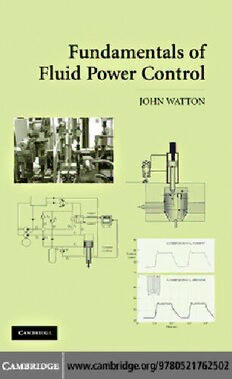Table Of ContentThis page intentionally left blank
FUNDAMENTALS OF FLUID POWER CONTROL
Thisexcitingnewreferencetextisconcernedwithfluidpowercontrol.
Itisanidealreferenceforthepracticingengineerandatextbookfor
advancedcoursesinfluidpowercontrol.Inapplicationsinwhichlarge
forcesand/ortorquesarerequired,oftenwithafastresponsetime,oil-
hydrauliccontrolsystemsareessential.Theyexcelinenvironmentally
difficult applications because the drive part can be designed with no
electrical components, and they almost always have a more competi-
tivepower–weightratiothanelectricallyactuatedsystems.Fluidpower
systemshavethecapabilitytocontrolseveralparameters,suchaspres-
sure,speed,andposition,toahighdegreeofaccuracyathighpower
levels.Inpractice,therearemanyexcitingchallengesfacingthefluid
powerengineer,whonowmusthaveabroadskillset.
John Watton entered industry in 1960 working on the design of heat
exchangers.HethenstudiedMechanicalEngineeringatCardiffUni-
versity,obtaininghisBScdegreefollowedbyhisPhDdegree.In1969,
hereturnedtoindustryasaSeniorSystemsEngineerworkingonthe
electrohydraulic control of guided pipe-laying machines. Following a
period at Huddersfield University, he returned to Cardiff University
in 1979 and was appointed Professor of Fluid Power in 1996, receiv-
inghisDScdegreeinthesameyear.HewasawardedtheInstitutionof
MechanicalEngineersBramahMedalin1999andaspecialawardfrom
theJapanFluidPowerSocietyin2005,bothforoutstandingresearch
contributionstofluidpower.
ProfessorWattonhasbeencontinuallyactiveasaresearcherand
consultantwithindustryinthepast40years.Hehasworkedoncom-
ponentsandsystemsdesign,manufacturingplantmonitoring,andthe
designofnewmobilemachines,andhehasactedasanExpertWitness
onavarietyoffluidpowerissues.HeisaCharteredEngineer,aFellow
ofthe Institution of MechanicalEngineers, and was elected a Fellow
oftheRoyalAcademyofEngineeringin2007.
Fundamentals of Fluid Power Control
John Watton,DScFREng
CardiffUniversity,SchoolofEngineering
CAMBRIDGE UNIVERSITY PRESS
Cambridge, New York, Melbourne, Madrid, Cape Town, Singapore,
São Paulo, Delhi, Dubai, Tokyo
Cambridge University Press
The Edinburgh Building, Cambridge CB2 8RU, UK
Published in the United States of America by Cambridge University Press, New York
www.cambridge.org
Information on this title: www.cambridge.org/9780521762502
© John Watton 2009
This publication is in copyright. Subject to statutory exception and to the
provision of relevant collective licensing agreements, no reproduction of any part
may take place without the written permission of Cambridge University Press.
First published in print format 2009
ISBN-13 978-0-511-60436-2 eBook (EBL)
ISBN-13 978-0-521-76250-2 Hardback
Cambridge University Press has no responsibility for the persistence or accuracy
of urls for external or third-party internet websites referred to in this publication,
and does not guarantee that any content on such websites is, or will remain,
accurate or appropriate.
Contents
Preface pagexi
1 Introduction,Applications,andConcepts. . . . . . . . . . . . . . . . . . . .1
1.1 TheNeedforFluidPower 1
1.2 CircuitsandSymbols 8
1.3 PumpsandMotors 11
1.4 Cylinders 16
1.5 Valves 17
1.6 Servoactuators 25
1.7 PowerPacksandAncillaryComponents 26
1.8 ReferencesandFurtherReading 31
2 AnIntroductiontoFluidProperties . . . . . . . . . . . . . . . . . . . . . . 33
2.1 FluidTypes 33
2.2 FluidDensity 39
2.3 FluidViscosity 40
2.4 BulkModulus 41
2.5 FluidCleanliness 49
2.6 FluidVaporPressureandCavitation 50
2.7 Electrorheological(ER)FluidsandMagnetorheological(MR)
Fluids 54
2.8 ReferencesandFurtherReading 58
3 Steady-StateCharacteristicsofCircuitComponents. . . . . . . . . . . . .61
3.1 FlowThroughPipes 61
3.1.1 TheEnergyEquation 61
3.1.2 LaminarandTurbulentFlowinPipes;theEffect
ofFluidViscosity 62
3.1.3 TheNavier–StokesEquation 62
3.1.4 LaminarFlowinaCircularPipe 64
3.1.5 TheGeneralPressure-DropEquation 66
3.1.6 TemperatureRisein3DFlow 68
3.1.7 ComputationalFluidDynamics(CFD)SoftwarePackages 69
v
vi Contents
3.2 Restrictors,ControlGaps,andLeakageGaps 74
3.2.1 Types 74
3.2.2 Orifice-TypeRestrictors 74
3.2.3 FlowBetweenParallelPlates 80
3.2.4 FlowBetweenAnnularGaps 81
3.2.5 FlowBetweenanAxialPistonPumpSlipperand
ItsSwashPlate 82
3.2.6 FlowBetweenaBallandSocket 89
3.2.7 FlowBetweenNonparallelPlates–ReynoldsEquation 90
3.2.8 FlowThroughSpoolValvesoftheServovalveType
andtheUseofaCFDPackageforAnalysis 95
3.2.9 FlowCharacteristicsofaCone-SeatedPoppetValve 100
3.2.10 ADoubleFlapper–NozzleDevicefor
Pressure-DifferentialGeneration 104
3.2.11 TheJetPipeandDeflector-JetFluidicAmplifier 109
3.3 Steady-StateFlow-ReactionForces 112
3.3.1 BasicConcepts 112
3.3.2 ApplicationtoaSimplePoppetValve 112
3.3.3 ApplicationtotheMainStageofaTwo-Stage
Pressure-ReliefValve 113
3.3.4 ApplicationtoaSpoolValve 115
3.3.5 ApplicationtoaCone-SeatedPoppetValve 117
3.3.6 ApplicationtoaFlapper–NozzleStage 119
3.4 OtherForcesonComponents 120
3.4.1 StaticandShear-StressComponents 120
3.4.2 TransientFlow-ReactionForces 121
3.5 TheElectrohydraulicServovalve 122
3.5.1 ServovalveTypes 122
3.5.2 ServovalveRating 123
3.5.3 FlowCharacteristics,CriticallyLappedSpool 125
3.5.4 ServovalvewithForceFeedback 127
3.5.5 ServovalvewithSpool-PositionElectrical
Feedback 129
3.5.6 FlowCharacteristics,UnderlappedSpool 130
3.6 Positive-DisplacementPumpsandMotors 133
3.6.1 FlowandTorqueCharacteristicsofPositive-
DisplacementMachines 133
3.6.2 GeometricalDisplacementofaPositive-Displacement
Machine 137
3.6.3 FlowLossesforanAxialPistonMachine 142
3.6.4 TorqueLossesforanAxialPistonMachine 148
3.6.5 MachineEfficiency–AxialPistonPump 152
3.6.6 MachineEfficiency–AxialPistonMotor 155
3.7 Pressure-ReliefValvePressure–FlowConcepts 158
3.8 SizinganAccumulator 159
3.9 DesignofExperiments 161
3.10ReferencesandFurtherReading 163
Contents vii
4 Steady-StatePerformanceofSystems . . . . . . . . . . . . . . . . . . . . . 171
4.1 DeterminingthePowerSupplyPressureVariationduring
OperationforaPump–PRV–ServovalveCombination:
AGraphicalApproach 171
4.2 Meter-OutFlowControlofaCylinder 172
4.3 AComparisonofCounterbalance-ValveandanOvercenter-Valve
PerformancestoAvoidLoadRunaway 174
4.4 DriveConcepts 177
4.5 PumpandMotorHydraulicallyConnected:AHydrostaticDrive 179
4.6 PumpandMotorShaftConnected:APowerTransferUnit(PTU) 183
4.7 Servovalve–MotorOpen-LoopandClosed-LoopSpeedDrives 189
4.7.1 Open-LoopControl 189
4.7.2 Closed-LoopControl 192
4.8 Servovalve–LinearActuator 195
4.8.1 Extending 195
4.8.2 Retracting 196
4.8.3 AComparisonofExtendingandRetractingOperations 198
4.9 Closed-LoopPositionControlofanActuatorbyaServovalve
withaSymmetricallyUnderlappedSpool 200
4.10LinearizationofaValve-ControlledMotorOpen-Loop
Drive:TowardIntelligentControl 203
4.11ReferencesandFurtherReading 207
5 SystemDynamics . . . . . . . . . . . . . . . . . . . . . . . . . . . . . . . . . 209
5.1 Introduction 209
5.2 MassFlow-RateContinuity 211
5.3 ForceandTorqueEquationsforActuators 211
5.4 SolvingtheSystemEquations,ComputerSimulation 213
5.5 DifferentialEquations,LaplaceTransforms,andTransfer
Functions 216
5.5.1 LinearDifferentialEquations 216
5.5.2 NonlinearDifferentialEquations,theTechniqueof
LinearizationforSmall-SignalAnalysis 219
5.5.3 UndampedNaturalFrequencyofaLinearActuator 221
5.5.4 LaplaceTransformsandTransferFunctions 223
5.6 TheElectricalAnalogy 225
5.7 FrequencyResponse 229
5.8 OptimumTransferFunctions,theITAECriterion 235
5.9 ApplicationtoaServovalve–MotorOpen-LoopDrive 239
5.9.1 FormingtheEquations 239
5.9.2 AnEstimateofDynamicBehaviorbyaLinearized
Analysis 239
5.9.3 AComparisonofNonlinearandLinearizedEquations
UsingthePhase-PlaneMethod 244
5.10ApplicationtoaServovalve–LinearActuatorOpen-LoopDrive 245
5.10.1 FormingtheEquations 245
5.10.2 AnEstimateofDynamicBehaviorbyaLinearized
Analysis 247
viii Contents
5.10.3 TransferFunctionSimplificationforaDouble-Rod
Actuator 248
5.11FurtherConsiderationsoftheNonlinearFlow-Continuity
EquationsofaServovalveConnectedtoaMotoror
aDouble-RodLinearActuator 249
5.12TheImportanceofShortConnectingLinesWhentheLoad
MassIsSmall 250
5.13ASingle-StagePRVwithDirectionalDamping 253
5.13.1 Introduction 253
5.13.2 FormingtheEquations,TransientResponse 255
5.13.3 FrequencyResponsefromaLinearizedTransfer
FunctionAnalysis 257
5.14ServovalveDynamics 259
5.15AnOpen-LoopServovalve–MotorDrivewithLineDynamics
ModeledbyLumpedApproximations 261
5.16TransmissionLineDynamics 265
5.16.1 Introduction 265
5.16.2 LosslessLineModelforZandY 267
5.16.3 AverageandDistributedLineFrictionModels
forZandY 270
5.16.4 Frequency-DomainAnalysis 271
5.16.5 Servovalve-ReflectedLinearizedCoefficients 275
5.16.6 ModelingSystemswithNonlosslessTransmission
Lines,theModalAnalysisMethod 278
5.16.7 ModalAnalysisAppliedtoaServovalve–Motor
Open-LoopDrive 282
5.17TheState-SpaceMethodforLinearSystemsModeling 285
5.17.1 ModelingPrinciples 285
5.17.2 SomeFurtherAspectsoftheTime-DomainSolution 291
5.17.3 TheTransferFunctionConceptinStateSpace 292
5.18Data-BasedDynamicModeling 293
5.18.1 Introduction 293
5.18.2 Time-SeriesModeling 294
5.18.3 TheGroupMethodofDataHandling(GMDH)
Algorithm 296
5.18.4 ArtificialNeuralNetworks 297
5.18.5 AComparisonofTime-Series,GMDH,andANN
ModelingofaSecond-OrderDynamicSystem 300
5.18.6 Time-SeriesModelingofaPositionControlSystem 304
5.18.7 Time-SeriesModelingforFaultDiagnosis 306
5.18.8 Time-SeriesModelingofaProportionalPRV 309
5.18.9 GMDHModelingofaNitrogen-FilledAccumulator 311
5.19SomeCommentsontheEffectofCoulombFriction 314
5.20ReferencesandFurtherReading 318
6 ControlSystems . . . . . . . . . . . . . . . . . . . . . . . . . . . . . . . . . . 323
6.1 IntroductiontoBasicConcepts,theHydromechanicalActuator 323
6.2 StabilityofClosed-LoopLinearSystems 326

